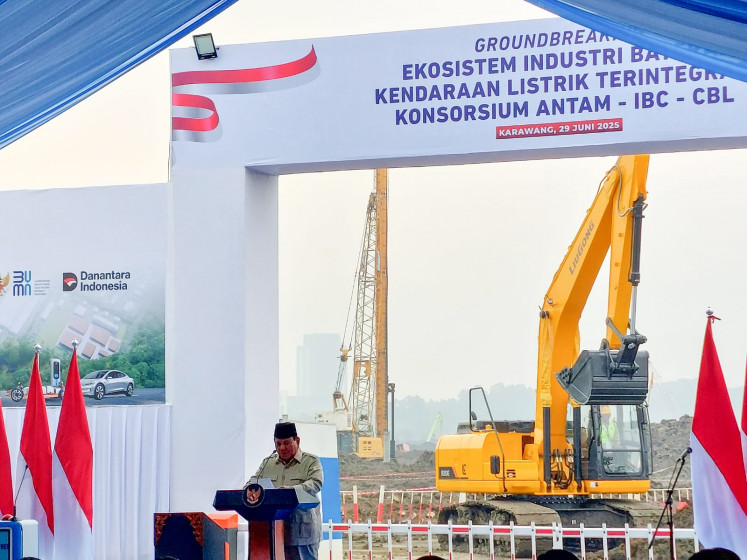Popular Reads
Top Results
Can't find what you're looking for?
View all search resultsPopular Reads
Top Results
Can't find what you're looking for?
View all search resultsAnalysis: Silver lining ahead for Indonesia’s tourism sector, amid coronavirus outbreak
The world has been struggling to fight the novel coronavirus (COVID-19) outbreak that has taken thousands of lives and disrupted economic activity, not just in China the virus epicenter, but also in many countries across the globe since the beginning of this year
Change text size
Gift Premium Articles
to Anyone

The world has been struggling to fight the novel coronavirus (COVID-19) outbreak that has taken thousands of lives and disrupted economic activity, not just in China the virus epicenter, but also in many countries across the globe since the beginning of this year.
According to a recent World Health Organization report, more than 78,000 people have contracted the pneumonia-like illness with 2,462 deaths to date. The statistics not only reveal a 3.12 percent fatality rate but have also caused worldwide virus hysteria. The virus has spread to 28 countries, disrupted businesses in China as well as in other countries following lockdowns and travel warnings to the world’s second-largest economy.
We already know that China is incredibly strong in manufacturing, but its tourists also play an increasingly important role in the world economy. A report from McKinsey & Company shows that 16 percent of international tourism spending was from Chinese tourists, reaching US$277 billion globally in 2018.
Chinese tourists also prefer to visit Asia-Pacific countries over European and American ones with more than 25 percent of total tourist arrivals in Thailand, Korea, Japan and Vietnam being Chinese.
In Indonesia, around 13.2 percent of 15.8 million of Indonesia’s total foreign tourist visitors in 2018 were Chinese. Last year, the country saw 16.1 million foreign tourist arrivals, with Chinese visitors contributing 12 percent of all foreign arrivals, second only after Malaysians.
On that basis, it is not hard to project that the travel ban slapped by 50 countries, including Indonesia, on China will hit global tourism hard. A survey conducted by The Economist shows that respondents believe the travel and tourism sectors will take the hardest hit, followed by logistics and manufacturing industries.
It is not the first time Indonesia’s tourism sector has faced a challenging period. The Severe Acute Respiratory Syndrome (SARS) outbreak in 2003 caused contractions in tourist arrivals for at least nine months, with the worst shrinkage happening in May when foreign arrivals fell by 39.4 percent year-on-year (yoy).
The figure was worse after the Bali Bombing II (-23.8 percent yoy in October 2005), Bali Bombing I (-18.1 percent yoy in November 2002) and 9/11 attack (-12.8 percent yoy on October 2001).
A question emerges: Does our hotel and tourism sector rely on international tourists?
In my article titled “Supporting Fundamental Factors for Tourism in Indonesia” published by The Jakarta Post on Oct. 2, 2019, it is clear that the hotel sector performance still depends strongly on domestic tourists. Tourism Ministry data shows that international tourist arrivals reached 15.8 million in 2018. Only 5.21 percent of total tourists visited or just a tiny fraction compared to Indonesian domestic tourist visits.
Apart from the huge differences between domestic and international tourists, we realized that domestic tourists on average spent fewer days on every trip compared to foreign visitors. In 2018, international tourists spent 2.9 days on average while Indonesians only spent 1.8 days traveling around the archipelago. However, the gap in spending between domestic and foreign tourists might be helped by the large number of Indonesians traveling around the country.
The government of Indonesia has still set a target of welcoming at least 17 million tourists this year. However, a downward revision might be required considering the latest development. Bank Mandiri’s chief economist projects that inbound international tourist visits this year might end up as low as 12.2 million visits if the outbreak lasts for six months. This projection could worsen to just 7.3 million visits if coronavirus hysteria lasts throughout 2020.
If we learn from the past, is it time to expect domestic tourists to save the day? Is it necessary for the government to encourage more domestic tourists to spend more and travel further around Indonesia?
If we look through occupancy rates in Jakarta and Bali as a proxy for hotel performance, we can glean some important points. First, the occupancy rate and the number of international tourists were positively correlated, especially during unfortunate events such as the 9/11 attack, the SARS epidemic and the 2002 and 2005 Bali bombings.
However, as we can see in Figure 1, Jakarta has been more resilient to the fluctuations of international tourist arrivals. This means that the domestic market strongly supported hotel performance. When the occupancy rate in Bali plunged during the SARS epidemic in the first half of 2003, the occupancy rate in Jakarta remained steady.
Despite this resilience, it will take some time for the tourism sector to recover amid the government’s plan to boost domestic tourism by offering airfare discounts.
However, an extended version of discounts on accommodation should be considered, since tourism is not always about traveling far. “Staycations”, for instance, might offer hope for the tourism sector in Indonesia, where the burgeoning middle class and rich millennial workers can help support the domestic tourism sector.
These particular markets do not need complex reasons for staycations or staying at a hotel near their home on a weekend or for a short holiday. The IDN Millennial Report 2019 shows that spending on entertainment including travel for millennials is as big as 8 percent of their total monthly spending, higher than insurance at 6.8 percent and investments at just 2 percent.
During this period of coronavirus hysteria, it is important to keep being optimistic while preparing for the worst. So, shall we wait for the discounts, pack our bags and travel? I think we should.
______
The writer is industry analyst at Bank Mandiri









